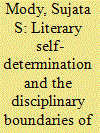| Srl | Item |
| 1 |
ID:
117601


|
|
|
|
|
| Publication |
2012.
|
| Summary/Abstract |
This article examines Mahavir Prasad Dwivedi's project of literary self-determination, as articulated in two programmatic essays published in the Hindi journal Sarasvati under his editorship (1903-1920), scrutinising his construction of literature as a culturally embedded category of national consequence. His theorisation of Hindi literature as broadly inclusive in terms of its basic definition and function supported the growth of what he considered a national treasury of literature. His discussion of its historical and linguistic parameters and his emphasis on a prioritised plan of literary production, reified the notion of a modern discipline oriented towards a narrowly constructed national collective that sought to establish its sovereign identity via literature in Khari Boli Hindi. Though not explicit in its anti-colonial nationalism, this project nevertheless privileged Hindi as the projected lead language of a modern sovereign nation, with all the risks that delimitation entailed.
|
|
|
|
|
|
|
|
|
|
|
|
|
|
|
|
| 2 |
ID:
134265


|
|
|
|
|
| Summary/Abstract |
The Hindi-language journal, Sarasvati (1900–82), belonged to a new breed of periodical, the illustrated monthly, emerging in India at the turn of the century. It pursued and established an integral connection between art and literature. In this essay, I examine visually-oriented strategies implemented by the journal's editor, M.P. Dwivedi, to establish literary authority amidst resistance to his poetic agenda. In particular, I focus on two of Dwivedi's earliest attempts at establishing literary authority through combined literary–visual narrative forms: literary criticism conveyed through editorial cartoons, and poetry inspired by, and accompanying, the paintings of Raja Ravi Varma. A closer look at the deliberate cultivation of such literary interactions with the visual provides the basis for a more nuanced history of the modernisation of Hindi poetry and indicates the interactive significance of literature and art across multiple regions in the early twentieth century.
|
|
|
|
|
|
|
|
|
|
|
|
|
|
|
|